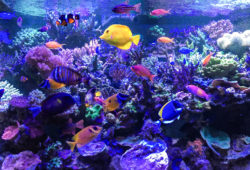The Algae-Eating Rabbitfishes
In the following article you will find some basic information on The Algae-Eating Rabbitfishes.

Contents
Tropical Marine Aquarium Fishes that Control Algae
The rabbitfishes are so named because of their face, which is said to resemble a rabbit (at least that’s how the Ancient Greeks saw it). Long underappreciated in the tropical marine aquarium hobby, many rabbitfish species are ideal tropical saltwater aquarium fish. They are generally quite hardy, disease resistant and are fantastic algae grazers. Oh yea…they are also attractive!
Most tropical aquarium specimens grow to about nine inches, although some do get much larger. While they are generally advertised as being “reef-compatible with caution,” too many aquarists have seen a rabbitfish decimate their coral (especially corals with large polyps) to, in good faith, recommend most rabbitfish species for a reef tank.
Rabbitfish Habitat and Tankmates
Mostly peaceful, Rabbitfishes are generally good candidates for a community tropical marine aquarium. They can be kept with most other fishes, so long as those fishes are not overly aggressive. Rabbitfishes have venomous spines that signal to most predators to steer clear. Make sure the rabbitfish has plenty of swimming space (at least 60 gallons for most) and several good hiding spots in the rockwork. Strong water movement and excellent filtration is a must. While rabbitfishes do travel in groups in the wild, they are best kept as individuals unless the aquarium is hundreds of gallons.
Rabbitfish Diet
As with most tropical marine fishes, looking at the fish’s mouth is a good indicator as to preferred diet. Rabbitfishes have small mouths designed to pick at algae, and the aquarist must offer a well-balanced herbivorous diet to keep these fishes healthy. In addition to eating caulerpa, hair algae, bryopsis, valonia, and red turf algae growing in the aquarium, the aquarist should supplement the diet with prepared herbivorous foods. Like most tropical marine fishes that are herbivores, rabbitfishes will also accept meaty foods (in the wild, they consume small crustaceans while eating algae). Do offer krill, raw table shrimp, squid, clam, and mussel.
Handling Rabbitfishes
Aquarists are advised to be careful when handling rabbitfishes, as these fishes can easily cause a painful wound that may require medical attention by way of their venomous spiny rays along their dorsal spine. These spines are also notorious for getting entangled in nets. As a result it is best to not net these fishes but instead to capture them using a container (e.g. specimen box).



